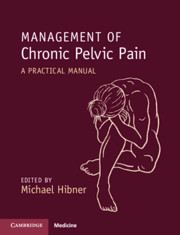Book contents
- Management of Chronic Pelvic Pain
- Management of Chronic Pelvic Pain
- Copyright page
- Contents
- Contributors
- Foreword
- Chapter 1 Introduction to Chronic Pelvic Pain
- Chapter 2 Neurobiological Basis of Pelvic Pain
- Chapter 3 History and Evaluation of Patients with Chronic Pelvic Pain
- Chapter 4 Psychological Assessment of a Female Patient with Chronic Pelvic Pain
- Chapter 5 Musculoskeletal Assessment for Patients with Pelvic Pain
- Chapter 6 Pharmacological Management of Patients with Pelvic Pain
- Chapter 7 Evidence for Surgery for Pelvic Pain
- Chapter 8 Pelvic Pain Arising from Endometriosis
- Chapter 9 Bladder Pain Syndrome
- Chapter 10 Pelvic Pain Arising from Pelvic Congestion Syndrome
- Chapter 11 Irritable Bowel Syndrome
- Chapter 12 Vulvodynia
- Chapter 13 Pelvic Pain Arising from Adhesive Disease
- Chapter 14 Pelvic Pain Arising from Ovarian Remnant Syndrome
- Chapter 15 Pudendal Neuralgia
- Chapter 16 Other Peripheral Pelvic Neuralgias
- Chapter 17 Chronic Pain After Gynecological Surgery
- Chapter 18 Pain Arising from Pelvic Mesh Implants
- Chapter 19 Treatment of Sexual Dysfunction Arising from Chronic Pelvic Pain
- Chapter 20 Physical Therapy Interventions for Musculoskeletal Impairments in Pelvic Pain
- Chapter 21 If Everything Else Fails
- Index
- References
Chapter 14 - Pelvic Pain Arising from Ovarian Remnant Syndrome
Published online by Cambridge University Press: 08 March 2021
- Management of Chronic Pelvic Pain
- Management of Chronic Pelvic Pain
- Copyright page
- Contents
- Contributors
- Foreword
- Chapter 1 Introduction to Chronic Pelvic Pain
- Chapter 2 Neurobiological Basis of Pelvic Pain
- Chapter 3 History and Evaluation of Patients with Chronic Pelvic Pain
- Chapter 4 Psychological Assessment of a Female Patient with Chronic Pelvic Pain
- Chapter 5 Musculoskeletal Assessment for Patients with Pelvic Pain
- Chapter 6 Pharmacological Management of Patients with Pelvic Pain
- Chapter 7 Evidence for Surgery for Pelvic Pain
- Chapter 8 Pelvic Pain Arising from Endometriosis
- Chapter 9 Bladder Pain Syndrome
- Chapter 10 Pelvic Pain Arising from Pelvic Congestion Syndrome
- Chapter 11 Irritable Bowel Syndrome
- Chapter 12 Vulvodynia
- Chapter 13 Pelvic Pain Arising from Adhesive Disease
- Chapter 14 Pelvic Pain Arising from Ovarian Remnant Syndrome
- Chapter 15 Pudendal Neuralgia
- Chapter 16 Other Peripheral Pelvic Neuralgias
- Chapter 17 Chronic Pain After Gynecological Surgery
- Chapter 18 Pain Arising from Pelvic Mesh Implants
- Chapter 19 Treatment of Sexual Dysfunction Arising from Chronic Pelvic Pain
- Chapter 20 Physical Therapy Interventions for Musculoskeletal Impairments in Pelvic Pain
- Chapter 21 If Everything Else Fails
- Index
- References
Summary
Ovarian remnant syndrome occurs in patients who have had attempted oophorectomy and part of the ovary was left behind. It often happens in patients who are undergoing total abdominal hysterectomy with bilateral salpingo-oophorectomy in the setting of severe pelvic adhesions. In those cases, the surgeon, to avoid injury to the ureter, which is not well visible, clamps gonadal vessels too close to the ovary and some ovarian tissue remains in the patient. The patient often experience severe, sharp unilateral pelvic pain that is cyclical in nature. On ultrasound there is often a cystic adnexal mass but lack of a mass does not rule out an ovarian remnant. Hormonal assays may also be helpful. Treatment is surgical but surgery for this condition may be overly difficult because the original surgery to remove the ovary was most likley difficult in the first place. Procedures to remove ovarian remnants should be performed only by highly qualified providers who are experienced in operating in the setting of severe adhesions. On a positive note, patients in whom ovarian remnant was successfully removed are almost always cured of their pain.
- Type
- Chapter
- Information
- Management of Chronic Pelvic PainA Practical Manual, pp. 150 - 155Publisher: Cambridge University PressPrint publication year: 2021

